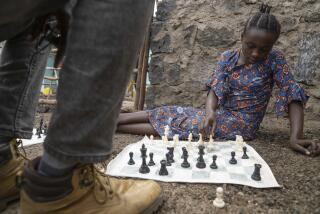Adrift on the chessboard
- Share via
The jacket of J.C. Hallman’s “The Chess Artist: Genius, Obsession, and the World’s Oldest Game” suggests that readers can anticipate a work in the tradition of Simon Winchester’s “The Professor and the Madman” on the making of the Oxford English Dictionary. We should expect, it seems, an erudite excursion into the history and making of a cultural treasure.
Surely chess, like the OED, has been a boon to civilization. Our chess past is as rich and textured as our lexicographical one, as Hallman’s intermittent discussions of the game’s relationship to art, science, philosophy, math and education indicate. But though “The Chess Artist” has its moments, it focuses almost exclusively on the gray and the black to the exclusion of the many other brilliant colors in the chess kaleidoscope.
Hallman deals mainly in three recurring topics. The shortest, most informative chapters present an account of the pieces, moves and rules of chess while providing an overview of the game’s evolution. Two travel narratives complete the triptych. One concerns a journey to Kalmykia, the only Buddhist state in Europe, citadel for the World Chess Federation (or simply FIDE) and home to the not-so-famous Chess City, a luxury complex built to host the 1998 Chess Olympiad. The other presents segments of the U.S. chess scene, with visits to New York’s chess clubs and stores, a Princeton math department game party (where John Nash makes a passing appearance) and prisons in Virginia and Michigan that arrange chess sessions for inmates. The entire opus presumably functions as an intellectual journey through the chess sands of time and space.
Accompanying Hallman on this expedition is his friend Glenn Umstead, a talented chess player whose aim is to become the first African American grandmaster. Umstead’s personal quest eventually fails when Maurice Ashley beats him to the finish line. Unfortunately Hallman, who describes himself as an amateur historian, leaves us hanging. We never learn why Umstead fails and Ashley succeeds.
Historians, whether amateur or professional, must be able to explain critical turning points and produce evidence of meaningful research. Yet Hallman’s chapters on the development of chess retell a well-known story already treated elsewhere by serious scholars. Admittedly, his writing is often fluid and not altogether without insight: “And then came the familiar painful sequence, that sequence in which you have only one move to make, and this invariably leads to another move you must make, and you realize that your opponent has anticipated all this even if you haven’t, and that he knows where you’re going even if you don’t.”
But all historians, including amateur ones, should differentiate between the noteworthy and the trifling. When Hallman finally gets his hoped-for interview with Kirsan N. Ilyumzhinov, president of Kalmykia and president of FIDE, the writer wastes his time and ours tossing no-brainers in the path of a master ranter. Predictably, Ilyumzhinov rants. Chess is and will be a religion, he proclaims, and we are forced to wade through the president’s self-promotional nonsense for several pages. Left unsettled are questions about the ruler’s alleged financial misappropriations and rumored involvement in criminal conspiracies in this Russian republic on the Caspian Sea. Millions may have been misspent to build Chess City, and Larisa Yudina, the journalist who investigated the claims, was brutally murdered in June 1998.
Back in the United States, Umstead conducts an exhibition at a Michigan prison. There he plays chess without looking at the board and performs admirably, though it’s not clear to what end. Then Hallman takes us to Virginia’s James River Correctional Center, where we spend quality time with convicted murderer and expert chess player Claude F. Bloodgood.
Bloodgood believes that playing chess lowers the rate of recidivism, and he makes other unoriginal though not unreasonable observations about the game. Still, Hallman confesses that the encounter turned up nothing that adds to anyone’s understanding of chess or its incarcerated exponent. The writer concludes that Bloodgood was “significant only for his clever web of lies” and ultimately “immaterial.” Why are we reading a text that declares its own irrelevancy?
Some really good chess players do happen to be sociopaths. The same is true of a comparably small percentage of mathematicians, scientists, artists, poets, philosophers -- even amateur historians. But one must question the purpose of a writer who bombards us with depictions of chess-playing deviants and misfits. Indeed, Hallman subscribes to a narrow perspective: “For chess players it comes down to a choice: One can become a tournament player, a nomad following the informal event circuit; a chess hustler, living on the cheap, sometimes cheating friends and counting on the ignorance of opponents; or a chess performer, a traveling act doing simuls and blindfolds.” Whatever happened to playing chess without any psychopathology, just for sheer fun?
But Hallman prefers to emphasize everything that confirms our oldest cliches. There they are again, the broken-down old men, with hair growing out of their ears and saliva dribbling down their chins. All they think about is playing chess, like Bobby Fischer, though without any of his over-the-board radiance. Where are the chess players who care about ideas, society and other people? The author, and other writers like him, would have us believe that they’re practically nonexistent.
Umstead often serves as a mere tool for reinforcing platitudes. “One of his chess player quirks was an irrational fear of germs,” Hallman writes, and he follows up this extraordinary generalization with the image of Umstead wiping his palm before every handshake. If you’re phobic about germs, wouldn’t you wipe your palms after, not before, every handshake? But I guess that wouldn’t seem as strange. To be sure, some of Hallman’s characters are Kafkaesque, and even his title alludes to “The Hunger Artist.” But at least Franz Kafka’s character endures for the good of humanity. It would be hard to find even a remotely well-intentioned reason for the behavior of many of Hallman’s subjects.
The text also suffers from ineffective metaphor and even pure banality. Take: “The weeds here always won, collapsing on everything like a storm of linked pawns.” Or: “He was black and I was white, and we were like chessmen opposed on a board that was the game itself.”
The chess world deserves so much more attention for its cultured and thriving life, for its fascinating history, for its beauty and its charm. Why exploit its chinks and weaknesses to seem clever? Why write about its sordid side as if that constituted its chief allure? Haven’t plenty of writers done that already? Like so many other issues this book raises or fails to, the answers will have to be found somewhere else.


